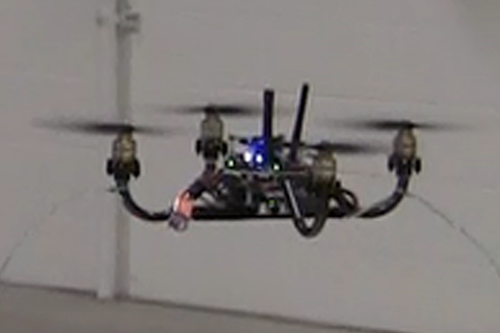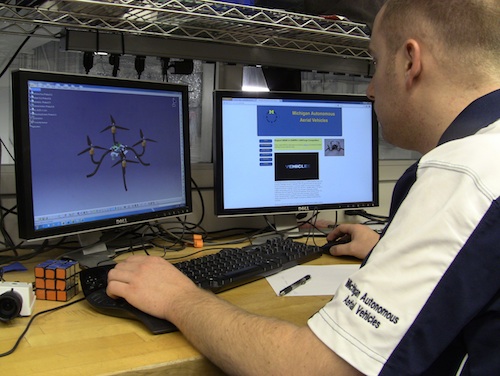Fast App: A Mouse That Roars
Team leader Danny Ellis leverages the 3D mice family and six degrees of freedom control for robot design and flight manipulation.
February 14, 2012
By DE Editors
When Danny Ellis was first introduced to CAD in high school with a course in Autodesk Inventor, little did he know he would someday be designing and flying aerial robots. As Ellis advanced into the engineering program at the University of Michigan, he was introduced to the powerful capabilities of CATIA, and it was there he also discovered 3Dconnexion 3D mice.
“In between my freshman and sophomore years, I became irritated at how cumbersome it was to rotate a model using a traditional mouse in CATIA,” says Ellis. “I thought, ‘I bet I could get a trackball mouse and program it so when I rotate the mouse, it rotates the part. I did a Google search to see if it had been done before, and that’s when I came across 3Dconnexion. It was exactly what I had been looking for. I ordered the SpaceNavigator right away, and haven’t stopped using it since.”

In 2009, during his senior year, Ellis began researching an aerial robot competition he could undertake at the university. Five days later, he started the Michigan Autonomous Aerial Vehicles (MAAV) team, with 15 members ranging from freshman to graduate students studying aerospace, computer, electrical and mechanical engineering. Within a week, the team kicked off its first quadrotor design for the International Aerial Robotics Competition (IARC). And at the end of the first year, MAAV successfully built two quadrotor vehicles capable of manual flight.
“The IARC challenge is to build a flying robot of any type you want “we chose a four-rotor helicopter “that can fly through an unknown building completely on its own,” explains Ellis. “There can be no communication with the device. The robot follows signs, must avoid detection from security cameras, locate a room, retrieve a flash drive, drop off the decoy, and get out in less than 10 minutes. No one has completed the mission yet, but we are one of the better teams competing. It’s the most challenging mission to date.”
When Ellis started the team, he wanted to get a 3Dconnexion 3D mouse for everyone.

“It makes modeling CAD designs so much faster and easier,” he says. In addition, the team quickly realized trying to fly the quadrotor with a standard joystick didn’t mimic the movements very well and wasn’t intuitive enough for the user, while a 3D mouse could mimic the exact movement of the robot. It was at this point the team decided to take matters into their own hands and control flight with a 3D mouse.
“We used the 3Dconnexion SDK to develop a driver to control the quadrotor with the SpaceExplorer, and it quickly allowed us to control pitch and roll, zoom control height, and rotation control yaw,” says Ellis. “In addition, the SpaceExplorer’s Intelligent Function Keys control other commands such as on/off and camera control. It is much more intuitive to fly the quadrotor with the 3D mouse “our team is very happy with the results.”
Today, Ellis is still the head of the MAAV team, while also completing two master’s degrees in aerospace engineering and robotics. He continues to use CATIA for all of his designing, both for the team and his class projects. He also works at a student lab training other students involved in competitions in CAD modeling and machining. 3D mice are integral to his training efforts.
“CATIA is a sophisticated and powerful application, and it takes time to learn how to interact with the model. This can be a barrier for people, especially if they’ve never used any CAD software before,” says Ellis. “3Dconnexion 3D mice make training new students much easier, helping them visualize how to move and rotate the model. And once they get that, it’s pretty much universal navigation across all CAD systems.”
Ellis currently uses the SpacePilot Pro.
“A 3D mouse allows me to easily interact with the model, while clicking and drawing in 3D at the same time,” says Ellis. “If you’re clicking with the standard mouse and also using it to position the part, it really interrupts the design flow.”
And, if Ellis goes into the lab and doesn’t have a 3D mouse with him? “It’s really tedious,” he says. “It takes me twice as long to do anything without a 3D mouse. Really, I couldn’t live without it.”
Subscribe to our FREE magazine, FREE email newsletters or both!
About the Author
DE’s editors contribute news and new product announcements to Digital Engineering.
Press releases may be sent to them via [email protected].






